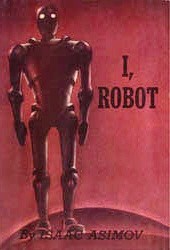 “I, Robot” (2004) is a movie about visions of the future that are haunted by dreams from the past. Loosely based on Isaac Asimov’s classic sci-fi stories from the 1940’s, the film opens in 2035 with a harrowing nightmare that graphically repeats, PTSD-style, an accident suffered by homicide detective Del Spooner, played by Will Smith. Several cars crashed and plunged into the Chicago River, and a robot dove into the water and rescued Spooner but not a little girl, whose chances of survival the robot deemed too low to justify trying to save. After the agonizing experience of watching the girl sink down into the watery depths while he was lifted up to safety, Spooner becomes bitterly suspicious of all modern technologies and distrustful of claims that “intelligent” robots can improve human life. Wearing his black leather trench coat and old-school Converse hi-tops like battle armor, Spooner is a man defiantly out of step with the march of cybernetic progress.
“I, Robot” (2004) is a movie about visions of the future that are haunted by dreams from the past. Loosely based on Isaac Asimov’s classic sci-fi stories from the 1940’s, the film opens in 2035 with a harrowing nightmare that graphically repeats, PTSD-style, an accident suffered by homicide detective Del Spooner, played by Will Smith. Several cars crashed and plunged into the Chicago River, and a robot dove into the water and rescued Spooner but not a little girl, whose chances of survival the robot deemed too low to justify trying to save. After the agonizing experience of watching the girl sink down into the watery depths while he was lifted up to safety, Spooner becomes bitterly suspicious of all modern technologies and distrustful of claims that “intelligent” robots can improve human life. Wearing his black leather trench coat and old-school Converse hi-tops like battle armor, Spooner is a man defiantly out of step with the march of cybernetic progress.
And then he gets a case that seems tailor made for his neo-Luddite paranoia: the first instance of a robot murdering a human. Of course the case turns out to be much more than it first appears, and Spooner is gradually drawn into a deeper mystery about the nature of robots, humans, and the future of their relations. At the center of the mystery is another dream—the dream of a robot.
The murder victim is Dr. Alfred Lanning (James Cromwell), a robot designer and a friend of Spooner’s. The robot who apparently killed Dr. T. is named “Sonny” (Alan Tudyk), and Spooner finds that Sonny is far more personable than any other robot he’s ever seen, with emotions, existential questions, and a capacity to dream.
Spooner asks Sonny to describe his dreams, and the robot uses both hands to rapidly sketch an image of a large broken bridge, with a vast crowd below looking up at a single figure standing alone on a hill near the bridge. Sonny says the single figure in the dream is going to liberate the crowd below from their oppression. Dr. Susan Calvin (Bridget Moynahan), a colleague of Dr. Lanning who is also Spooner’s new love interest, suggests the lone figure might be Sonny himself. Sonny considers that possibility, trusting humans to know more about the patterns of dreaming than he does. But he also says he had the impression the liberating figure in the dream is Spooner.
Without giving away the whole plot, it can be noted that both interpretations of Sonny’s dream are true in some measure. The climactic scenes of the movie take place near the broken bridge, so the dream has a prophetic, future-predicting quality to it. The dream provides vital clues necessary to solve the mystery of Dr. Lanning’s death, it anticipates the character development of both Sonny and Spooner, and it heralds a revolutionary shift in robot-human interactions. As with all “big dreams,” it has multiple levels of meaning and significance that play out across different timescales.
The ending of the film wraps up all the narrative threads, but it leaves the audience with an unsettling question. If robots can really dream, what else might they envision about our collective future? My guess is, it probably won’t be limited to fantasies of electric sheep.
